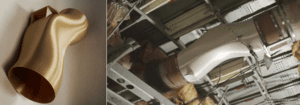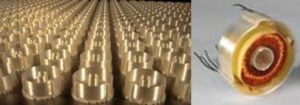Fused Deposition Modeling (FDM) is the most widely used 3D printing technology today, ranging from desktop printers to industrial scale manufacturing tools. While the use of FDM for prototyping and rapid tooling is well established, its use for manufacturing end-use parts in aerospace is a more recent phenomenon. This has been brought about primarily due to the availability of one material choice in particular: ULTEM. ULTEM is a thermoplastic that delivers compliance with FAA FAR 25.853 requirements. It features inherent flame retardant behavior and provides a high strength-to-weight ratio, outstanding elevated thermal resistance, high strength and stiffness and broad chemical resistance (official SABIC press release).
During an industry scan I conducted for a recent research proposal PADT submitted, I came across several examples of the aerospace industry using the FDM process to manufacture end-use parts. Each of these examples is interesting because they demonstrate the different criteria that make FDM preferable over traditional options, and I have classified them accordingly into: design opportunity, cost and lead-time reduction, and supply complexity.
Design Opportunity: In this category, I include parts that were primarily selected for 3D printing because of the unique design freedom that layer-wise additive manufacturing offers. This applies to all 3D printing technologies, the two examples below are for FDM in ducts.
ULA Environmental Control System (ECS) duct: As reported in a prior blog post, United Launch Alliance (ULA) leveraged FDM technology to manufacture an ECS duct and reduce the overall assembly from 140 parts to only 16, while reducing production costs by 57%. The ECS ducts distribute temperature and humidity controlled air onto sensitive avionics equipment during launch and need to withstand strong vibrations. The first Atlas V with these ducts is expected to launch in 2016.

Orbis Flying Eye Hospital aircraft duct: The Flying Eye Hospital is an amazing concept from Orbis, who use a refurbished DC-10 plane to deliver eye care around the world. The plane actually houses all the surgical rooms to conduct operations and also has educational classrooms. The refurbishment posed a particular challenge when it came to air conditioning: a duct had to transfer air over a rigid barrier while maintaining the volume. Due to the required geometric complexity, the team selected FDM and ULTEM to manufacture this duct, and installed it and met with FAA approval. The story is described in more detail in this video.

Supply Complexity: 3D printing has a significant role to play in retro-fitting of components on legacy aircraft. The challenge with maintaining these aircrafts is that often the original manufacturer either no longer is in business or makes the parts.
Airbus Safety belt holder: Airbus shared an interesting case of a safety belt holder that had to be retrofitted for the A310 aircraft. The original supplier made these 30 years ago and since went out of business and rebuilding the molds would cost thousands of dollars and be time-consuming. Airbus decided to use FDM to print these safety belt holders as described in this video. They took a mere 2 hours to design the part from existing drawings, and had the actual part printed and ready for evaluation within a week!

Incidentally, the US Air Force has also recognized this as a critical opportunity to drive down costs and reduce the downtime spent by aircrafts awaiting parts, as indicated by a recent research grant they are funding to enable them to leverage 3D printing for the purpose of improving the availability of parts that are difficult and/or expensive to procure. As of 2014, The Department of Defense (DOD) reported that they have maintenance crews supporting a staggering 31,900 combat vehicles, 239 ships and 16,900 aircraft – and identified 3D printing as a key factor in improving parts availability for these crews.
Cost & Lead-time Reduction: In low-volume, high-value industries such as aerospace, 3D printing has a very strong proposition to make as a technology that will bring products to market faster and cheaper. What is often a surprise is the levels of reduction that can be obtained with 3D printing, as borne out by the three examples below.
Airbus A350 Electric wire covers: The Airbus A350 has several hundred plastic covers that are 3D printed with FDM. These covers are used for housing electric wires at junction boxes. Airbus claims it took 70% less time to make these parts, and the manufacturing costs plunged 80%. See this video for more information.

Kelly Manufacturing Toroid housing: Kelly Manufacturing selected FDM to manufacture toroid housings that are assembled into their M3500 instrument, which is a “turn and bank” indicator which provides the pilot information regarding the rate of aircraft turn. These housings were previously made of urethane castings and required manual sanding to remove artifacts from the casting process, and also had high costs and lead times associated with tooling. Using FDM, they were able to eliminate the need to do sanding and reduced the lead time 93% and also reduced per-piece costs by 5% while eliminating the large tooling costs. See the official case study from Stratasys here.

These examples help demonstrate that 3D printing parts can be a cost savings solution and almost always results in significant lead time reduction – both of vital interest in the increasingly competitive aerospace industry. Further, design freedom offered by 3D printing allows manufacturing geometries that are otherwise impossible or cost prohibitive to make using other processes, and also have enormous benefit in overcoming roadblocks in the supply chain. At the same time, not every part on an aircraft is a suitable candidate for 3D printing. As we have just seen, selection criteria involve the readily quantifiable metrics of part cost and lead time, but also involve less tangible factors such as supply chain complexity, and the design benefits available to additive manufacturing. An additional factor not explicitly mentioned in any of the previous examples is the criticality of the part to the flight and the safety of the crew and passengers on board. All these factors need to be taken into consideration when determining the suitability of the part for 3D printing.


















